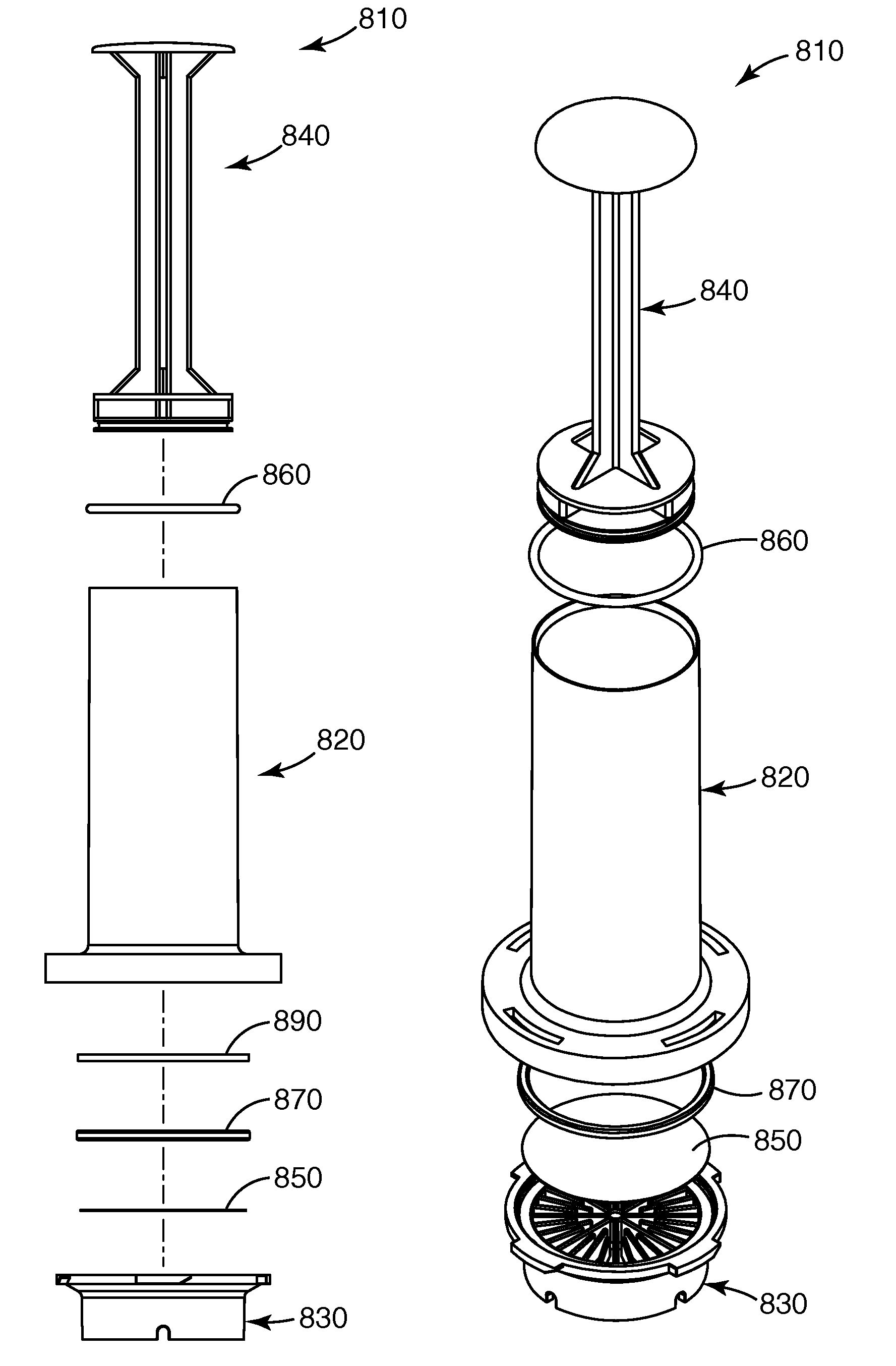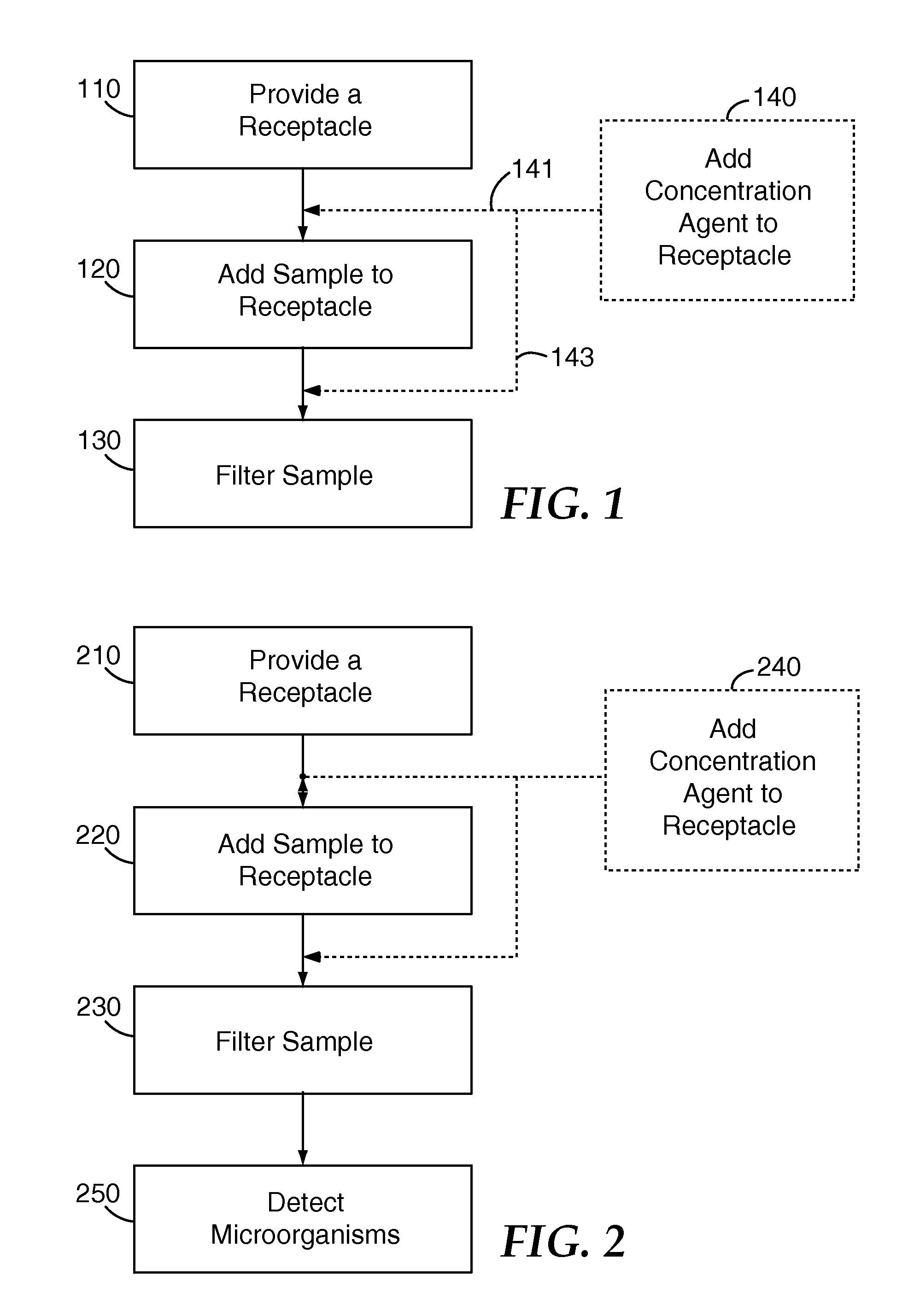Methods, kits and systems for processing samples
a technology of microorganisms and kits, applied in the field of methods, kits, systems and devices for processing samples for microorganism analysis, can solve the problems of unsuitable on-site applications, complex instruments and highly trained personnel, and high cost of standard methods for enumerating bacteria in water samples
- Summary
- Abstract
- Description
- Claims
- Application Information
AI Technical Summary
Problems solved by technology
Method used
Image
Examples
example 1
[0137]A microporous polyvinylidene fluoride (PVDF) film was prepared using a 40 mm twin screw extruder. PVDF polymer pellets (3M / Dyneon 1012) were introduced into the hopper of the extruder. The extruder was set with a screw speed of 150 RPM. The nucleating agent (HYPERFORM® HPN-68L), in powder form, was premixed in a 2 liter batch with the glycerol triacetate diluent (TRIACETIN® glycerol triacetate) with a ULTRA TURRAX® T-25 Basic high shear mixer from IKA Works, Inc. (Wilmington, N.C.) for a period of about 5 minutes (there is only one speed for the unit) to uniformly distribute the powder in a non-agglomerated, non-gritty, smooth to the touch state and then fed, with additional diluent, by a feeding device into the extruder via a port. The PVDF polymer / diluent / nucleating agent weight ratio was 39.85 / 60.00 / 0.15 respectively. The total extrusion rate was about 13.6 kg / hr; the cast speed was 1.6 m / min. The extruder had eight zones with a temperature profile of zones 1 to 8 at 188° C...
example 2
[0143]A 3M PPS Paint Preparation System was obtained and modified as follows. The lid with mesh support was generated using a Dremel cutting wheel to remove the lower support ring from the 3M PPS Paint Preparation System lid. The resulting surface was sanded smooth using 100 grit Wet-or-Dry sandpaper (3M Company, St. Paul, Minn.). The adapter ring was generated in a similar fashion from a second lid using a Dremel cutting tool to remove the top portion of a 3M PPS Paint Preparation System lid followed by sanding. These modifications allowed the filter to be “pinched” around its perimeter between the smooth surfaces of the lid and adapter ring during device assembly. The final modification was to cut a larger hole in the base of the outer cup to facilitate access to the liner during sample processing. Assembly and use of the device is described below.
[0144]A microporous polyvinylidene fluoride (PVDF) film was prepared using a 40 mm twin screw extruder. PVDF polymer pellets (3M / Dyneon...
example 3
[0149]3M PPS Paint Preparation Systems were modified as explained in Example 2 above.
[0150]An isolated E. coli (ATCC 51813) colony was inoculated into 5 ml BBL Trypticase Soy Broth (Becton Dickinson, Sparks, Md.) and incubated at 37° C. for 18-20 hours. This overnight culture at approximately 109 colony forming units / ml (CFU / ml) was diluted in Butterfield's Buffer (pH 7.2, VWR, West Chester, Pa.). A 1:1000 further dilution from a 102 cfu / ml dilution was done in 100 ml of potable water resulting in a final concentration of 0.1 / ml (10 cfus total). The liner was placed in the cup, followed by addition of the spiked sample. 250 milligrams of various concentration agents were added (see Table 1 for specific concentration agents). The X296-Talc was produced as seen in U.S. Pat. No. 6,045,913; and CM-111 in the table refers to 3M Cosmetic Microspheres, [CM-111]. The adapter ring was then placed on the liner followed by placing either a nylon membrane (F150A0A or F150COA 3M CUNO, pore size ...
PUM
 Login to View More
Login to View More Abstract
Description
Claims
Application Information
 Login to View More
Login to View More - R&D
- Intellectual Property
- Life Sciences
- Materials
- Tech Scout
- Unparalleled Data Quality
- Higher Quality Content
- 60% Fewer Hallucinations
Browse by: Latest US Patents, China's latest patents, Technical Efficacy Thesaurus, Application Domain, Technology Topic, Popular Technical Reports.
© 2025 PatSnap. All rights reserved.Legal|Privacy policy|Modern Slavery Act Transparency Statement|Sitemap|About US| Contact US: help@patsnap.com



